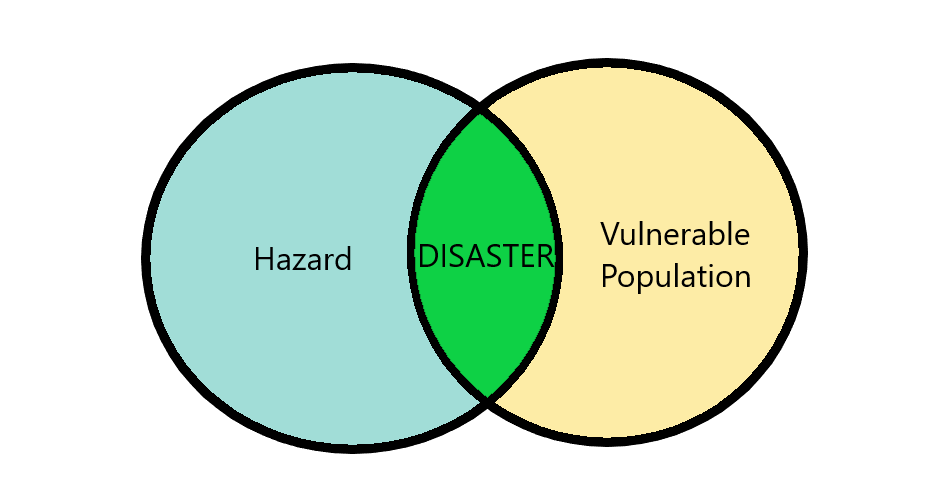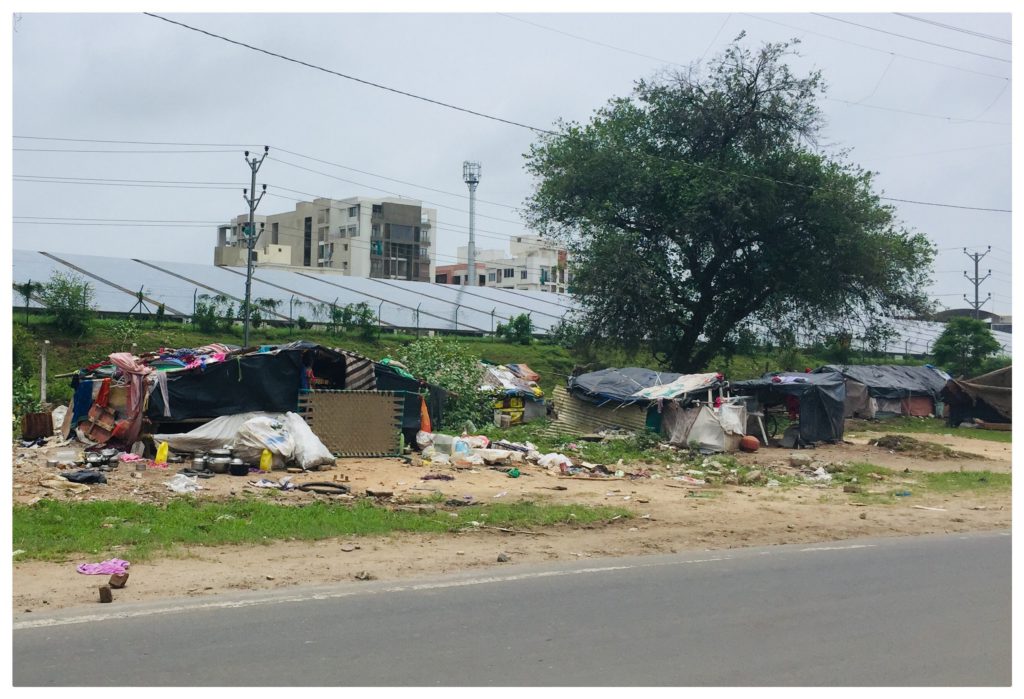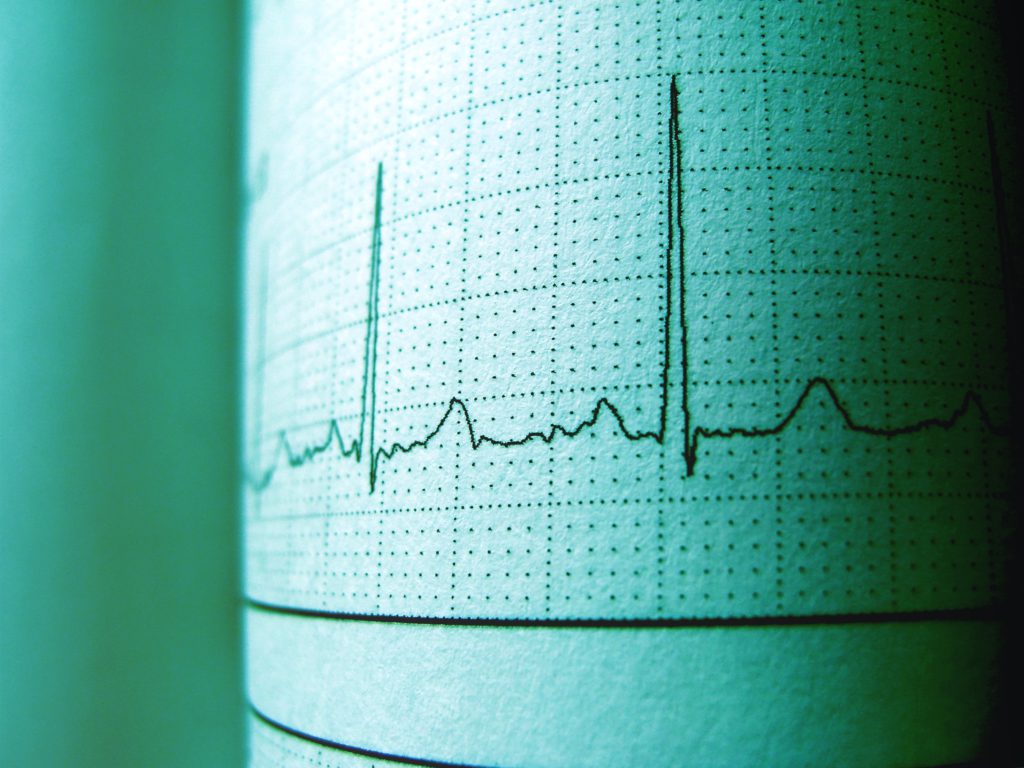A serious disruption of the functioning of a community or a society involving widespread human, material, economic or environmental losses and impacts, which exceeds the ability of the affected community or society to cope using its own resources.
UN definition of a disaster
A natural hazard is a natural events that has the potential to harm people and their property.
A disaster is the realisation of the hazard, i.e. harm has occurred.
Have a look at some definitions of ‘hazard’ and ‘disaster’ and see how similar or different they are – have a look at some insurance companies and their definition, like monetary loss.

Deggs Model of disasters shows they occur at the intersection between a hazardous natural event and a vulnerable population which experiences human and/or economic loss
Risk
Risks can be difficult to evaluate as they are changed by perception – determined by if a population chooses to ignore, adjust to or mitigate a hazard. There are other factors which can affect the ability to measure and manage risk, namely the economy, society and public perception.
The relationship between risks, hazards and people is complex, due to:
- Unpredictable Hazards – including timing, frequency and magnitude
- Lack of Alternatives – inability to go elsewhere or avoid
- Dynamic Hazards – hazards change overtime and can be improved or worsened by human interference
- Cost / Benefit Analysis of adaptation and mitigation
- Fatalism – acceptance of risks
- Population demographics – whereby older and very young populations are more vulnerable
Measuring Risk is accomplished by this equation
risk = (hazard x vulnerability)/capacity to cope
Resilience
Disaster resilience is the ability of individuals, communities, organisations and states to adapt to and recover from hazards, shocks or stresses without compromising long-term prospects for development. There are more definitions below:
The ability of countries, communities and households to manage change, by maintaining or transforming living standards in the face of shocks or stresses – such as earthquakes, drought or violent conflict – without compromising their long-term prospects.
DFID, 2011
The capacity of a system, community or society potentially exposed to hazards to adapt, by resisting or changing in order to reach and maintain an acceptable level of functioning and structure.
UNISDR, 2005
Some communities have a high capacity to cope and a high resilience as a result, factors such as investment in suitable infrastructure, prepared populations through education and effective planning and management can impact resilience, and many rely on an economy to support these efforts.
Nations can reduce the chances of disaster if they have effective preparations and coping mechanisms:
- The ability to anticipate disasters or monitor hazards
- Planning and preparation for hazards and their aftermath
- Emergency evacuation measures, including rescue and relief programmes
- Well educated and trained populations in how to act during a hazard
- Emergency relief funds to affect populations
- Hazard resistant designs or land-use planning to reduce affected people
Better preparation means a population is less likely to be affected by disaster.
Why do people live by tectonic hazards?
In 2000, it was estimated that 500 million people live on or close to volcanoes, and an estimated 600 million people will be living in tectonically active areas by 2025. Many people live in tectonically active zones, think of California, Iceland and the 961,000 people in Naples, Italy, despite being at the foot of the dangerous Mount Vesuvius.
People may reside in tectonically active areas due to historic settlements that have grown overtime, which would be hard to re-locate. The tectonic hazards may to many be believed to be low risk and infrequent or preparations seen as sufficient to protect people and property from harm. In richer areas, tectonic activity can create job opportunities, while in poorer areas some may not be able to relocate themselves to safety.
Natural resources in hazardous areas, like the fertile ash or hardy basalt from volcanoes, provides natural resources that can be used for industry and growth. Moreover, magma contains a large amount of minerals, such as, copper, gold, silver, lead and zinc which can be mined. Geothermal energy can also be extracted by the fissures of the Earth and supply local populations.
Alongside natural resources which generate income, there is also tourism. Many people pay to see volcanoes for example and this itself promotes the tourist industry. This generates revenue, and coupled with people believing tectonic hazards to be low-risk, means tourism means people reside and visit these sites.
Culturally speaking, volcanoes and earthquakes can hold cultural or religious significance. People in Mount Merapi, Indonesia believe in spirits on the mountain and offer gifts in exchange for warnings of eruptions. Volcanoes and earthquakes can be signs of an omnipotent being and as such, people may live in tectonically active areas to feel closer.
Effects of Tectonic Activity

The effects of tectonic activity can be grouped into two categolries:
Primary Effects
What happens immediately afterwards
Secondary Effects
What happens in the hours, days and weeks afterwards
The effect of tectonic activity can vary depending on:
- The size and magnitude of the tectonic activity, such as earthquakes that score higher on the Richter scale are likely to be more destructive. The greater pressure under a volcano can result in more lava flows that could impact those on the volcano or downhill.
- The distance from the volcano or earthquake epicentre, where the closer you are, the more likely to be affected or face severe loss
- The type of volcano or depth of focus, where Cinder Cones or Composite volcanoes, or earthquakes at a shallower depth are likely to be more destructive due to the volcano content or proximity to the surface
- The level of development can greatly impact the infrastructure and buildings, as well as the ability to predict tectonic activities and prepare for them. Evacuation strategies or rescue initiatives can reduce the risk of death
- Population density, similar to proximity to a tectonic hazard, can mean more people can be affected and at risk. This can mean more people in an area increases the likelihood of injury and death.
- The time of day can severely impact the number of people at risk, as people could be at work, travelling or at home due to the time of day. Whether tectonic activity happens during the day (and sunlight) or night can also affect the ability to prepare and respond.
Responses to Tectonic Activity

Response are how countries react to an Earthquake, and they can be categorised as:
Short-term or immediate – a response in the days and weeks immediately after a disaster has happened. Short-term responses mainly involve search and rescue and helping the injured.
Immediate responses to tectonic hazards include:
- Issuing warnings or sirens to warn populations
- Rescue teams searching for survivors and recovering bodies
- Providing treatment to injured people
- Food, drink and shelter provided
- Infrastructure protected and restored to prevent further risks, like fires or contamination
Long-term – these are responses that go on for months and years after a disaster. It involves rebuilding society and improving the economy, and can involve reconstruction and preparation.
Long-term responses to tectonic hazards include:
- Rebuilding and repairing properties
- Rebuilding and repairing infrastructure, including restoring utilities like water and gas
- Improving building regulations, which can include demolition of unsafe buildings or reconstructing others
- Resettlement schemes to move local people
- Loans to provide quick economic input to help people and businesses
- Developing opportunities for the economy to recover
- Install monitoring equipment
The responses to tectonic activity can vary depending on:
- The nature of preparation and response planning to effectively prevent disaster or lessen the risk to people can impact responses. If nations have invested in infrastructure to be resilient or have greater planning to tackle tectonic hazards, like national reserves for this eventuality, then they are in a better place to respond.
- The size and magnitude of destruction caused by the tectonic activity, the larger the earthquake or bigger the eruption, the more there is to restore in society.
- The distance from the volcano or earthquake epicentre, including the location and remoteness. The more remote an area or less densely populated, the less easy it may be to access affected people. The other affects from tectonic activity, such as landslides or mudflows, could cause further problems locating people or re-building.
- The level of development can greatly impact the nature of destruction and response. If many buildings have collapsed, mainlines have burst or been destroyed due to their vulnerable nature or lack of hazard precaution, this can make recovery longer.
- The economy and its main sources of revenue, including sectors, can impact the response and ability to re-build. Struggling economies or those whose sectors where impacted by the tectonic activity, such as ash falling on agricultural land smiting the produce, can elongate the time it takes to recover.
Managing the risks of a Tectonic Activity
The management of tectonic hazards fit into 3 different categories, Monitoring, Protection and Preparation.
For every category think how they help populations and avoid disaster. What nations would have access to the resources and why?
Monitoring or Prediction

Prediction involves attempting to state when a tectonic hazard would occur and its power. This helps plan for a tectonic hazard and can help evacuate populations, build resilient buildings or plan effectively. Seismometers help monitor tremors and can build trend and analysis to predict an earthquake and measure it, or measure tremors prior to an eruption as seismic activity increases. Good seismographs are connected to bedrock (very deep rock) to stop it recording anything other than an earthquake.
Measuring PH levels of water is also a way of monitoring volcanoes as they release gases into the water that change PH and impact nature. Not all volcanoes will release gases or release them in large enough quantities to make a difference until the eruption however.
Monitoring ground deformation and using satellite imagery can also help anticipate tectonic activity. The movement of magma can cause the Earth to deform in parts, including swelling near volcanoes. By measuring and tracking changes in tectonic areas, you can measure activity and likelihood of a tectonic hazard. Satellite images and remote sensing can also measure movement and monitor changes of the Earth’s surface. Satellites can also measure thermal energy which can also denote a volcanic eruption.
Protection

Protection involves constructing resilient buildings that are less likely to be impacted severely by earthquakes, so they should not collapse. Resilient buildings can have shock absorbers in the foundations to absorb tremors or steel frames to move with the Earth’s movements. Moreover, open areas can help gather people outside of buildings away from collapse and assist in assembly during evacuation. This form of protection aims to reduce injuries and deaths caused by collapsed buildings and also helps reconstruction costs as there is less to re-build.
Building a dam or trench is another way of protecting populations and land from the affects of tectonic activity. Dams or walls can block the flow of lava or debris like mud, but, depending on the power of the force, can easily destroy the wall or dam. A trench is similar in that it directs where lava or debris should go, such as away from the population. Again. if the lava or debris overflows it can head towards a population or land.
One over method of protection is using water too act as a coolant for lava. This can be an expensive and takes a lot of time to cool molten hot lava. This method may work if close to a water source, and there is an abundance of water, but it is difficult to tell how hot lava would be and how much would be required to effectively slow and cool it.
Preparation

Preparing for a disaster comprises of anticipation and planning for the eventuality. It can include educating the population in the hazard, it’s frequency and what to do in the event of a hazard to protect themselves and property. This can include escape drills, how to evacuate and understanding warning signs like drills. If people understand the threat, they can make an educated decision on how to protect themselves and others.
Preparation is also training people and organisations in how to respond to a hazard, including triggers and notifications, and then deploying personnel to the relevant places to assist. This could be deploying the army to assist civilians to the safest places. Training and employing such people, including rescue and recon, can be vital in maintaining services, utilities and lives after a hazard.
In Japan there is disaster day each year when all civilians and the emergency services practice what to do in the event of a disaster such as an earthquake, volcano or tsunami.
If you lived in a tectonically active area, how would you prepare and what would you recommend is done by national planners to mitigate against hazards?


